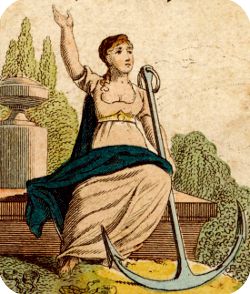Austrian Cartomancy Cards
During the 19th century a system of fortune telling arose in Europe using unnumbered, pictorial cards depicting popular imagery with subtitles in several languages.
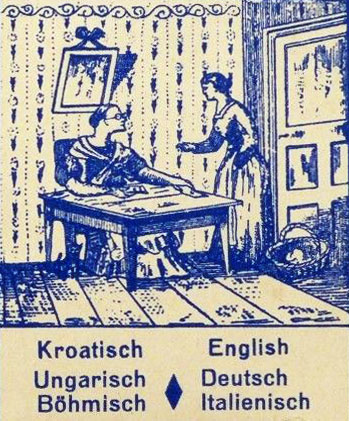
During the 19th century a system of fortune telling arose in Europe using unnumbered, pictorial cards depicting popular imagery with subtitles in several languages. These cards continue to be sold today under various names such as Sehr Feine Aufschlagkarten, Fortune Telling Cards, Gypsy Fortune Telling, Zigeuner or Biedermeier Cartomancy Cards. Many seem to have originated in Austria, but they also emanate from Germany and Hungary.
These oracle cards contain several images that were originally seen as vignettes in earlier divination games as well as cartomancy sets devised by Lenormand and her successors, but the whole repertoire has become a distinctive tradition with unique images and a format of its own. They are not the same as Le Jeu du Destin or the Parlour Sibyl. The cards are unnumbered and do not contain playing card insets as the Lenormand type do. The images, which may serve to facilitate clairvoyance or just for light-hearted readings, are allegorical and evocative, presented in a popular style: Hope is a woman with an anchor, Fidelity shows a dog by his master's grave. Inconstancy in the earlier sets, showing a man and a woman quarrelling, is replaced with Constancy, an all-seeing eye (Das Auge Gottes / Oko Boží) in editions by Piatnik published in Vienna and Budapest.
Hegenauer “Aufschlagkarten” Fortune Telling Cards
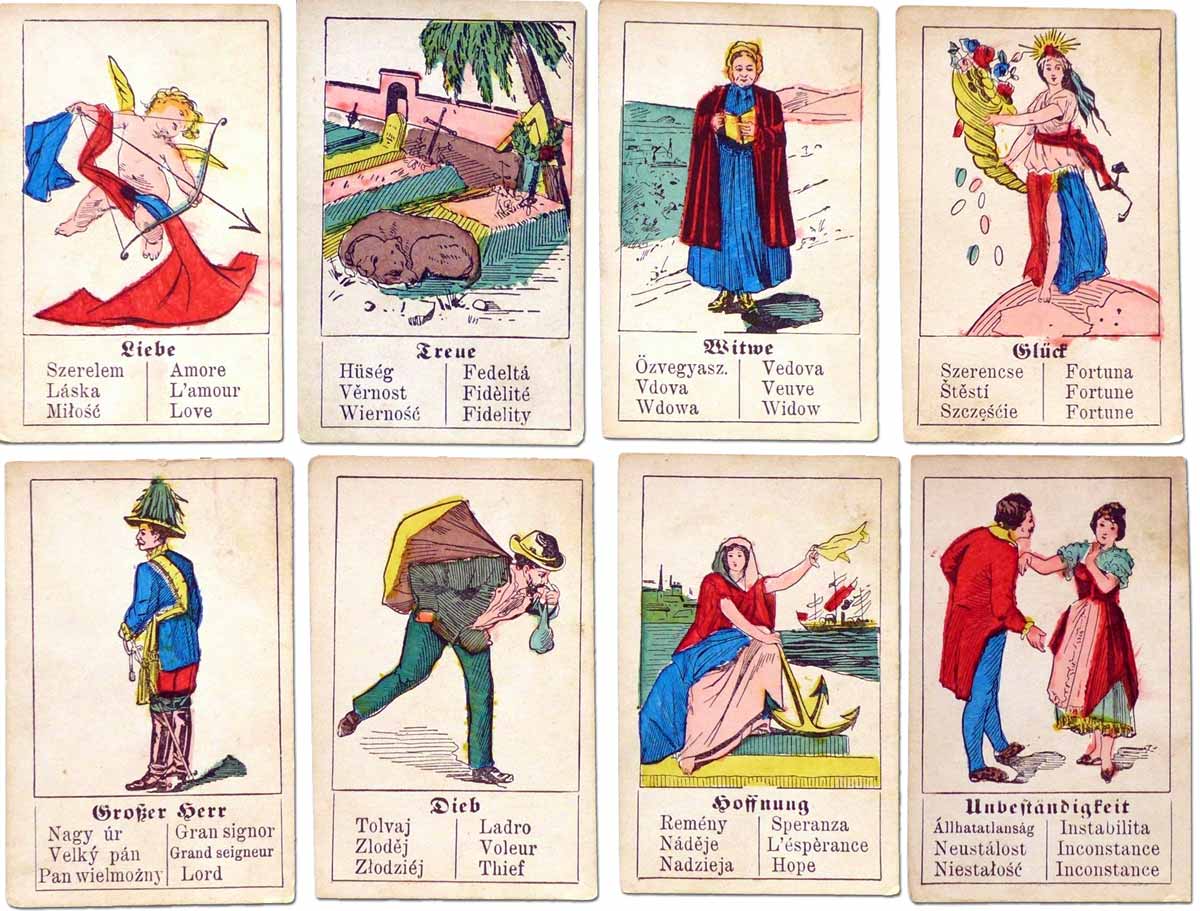
Above: Fortune Telling Cards manufactured in Austria by Wilhelm Hegenauer, 32 or 52 cards with captions in seven languages including English, designed for light-hearted interpretations, hand-coloured, c.1890. Inconstancy is shown here as a man and woman quarrelling.
Piatnik “Sehr Feine Aufschlagkarten” Fortune Telling Cards Nr.1
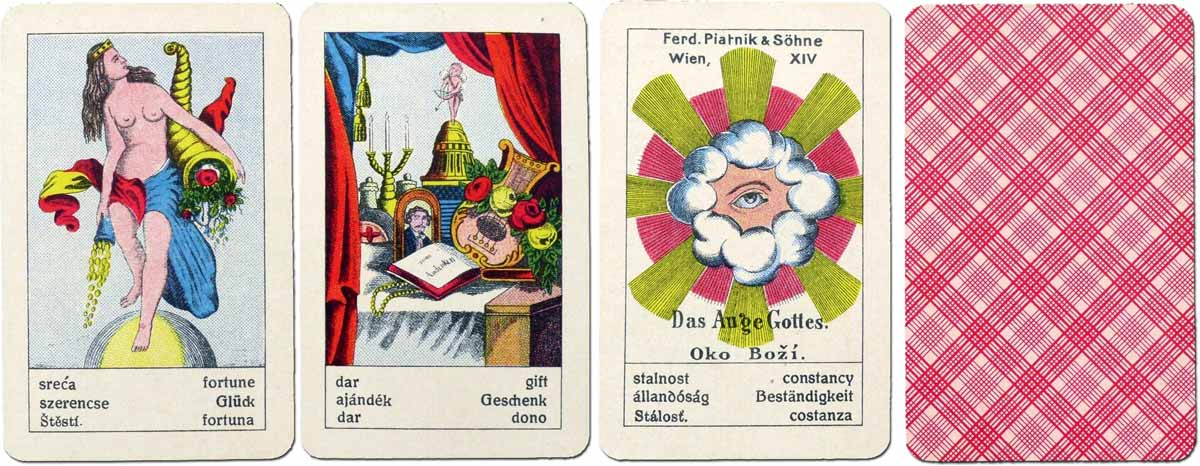
Above: Piatnik Fortune Telling Cards manufactured in Austria. Similar packs were also produced by Fabrik Ferd. Piatnik & Söhne in Budapest. The charming images depict various life circumstances from around 1900. The captions are in six languages.
Piatnik “Biedermeier” Fortune Telling Cards
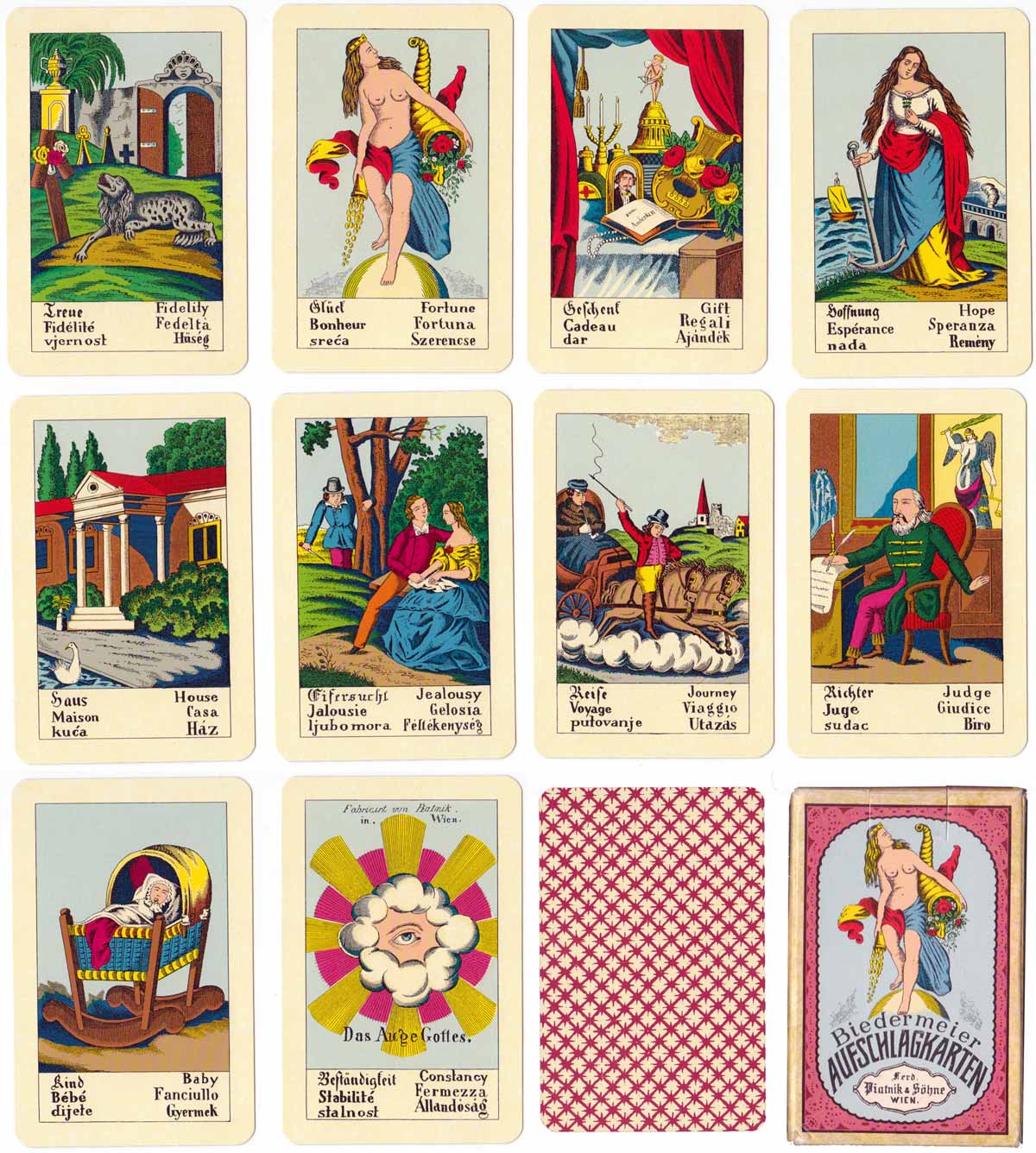
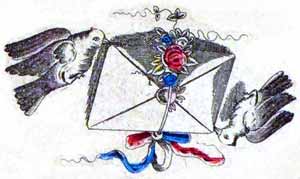
Above: Piatnik Biedermeier Fortune Telling Cards manufactured in Austria. 32 cards. The images are the same as in the above set, depicting life situations from around 1900, executed in the brightly coloured Biedermeier artistic style. The captions in six languages are printed in different typefaces evoking their cultural backgrounds: German, English, French, Italian, Hungarian, and Croatian. Images courtesy Rex Pitts.
The oldest of the unnumbered Austrian Cartomancy sets contain only 32 cards, like the 32-card decks used by the gypsys, but over time more cards were added reflecting more of life's situations or states of mind, so there are decks with 32, 36, and 52 cards. See also the Art-Deco Fortune Telling deck by Piatnik→
Hungarian Fortune Telling Cards
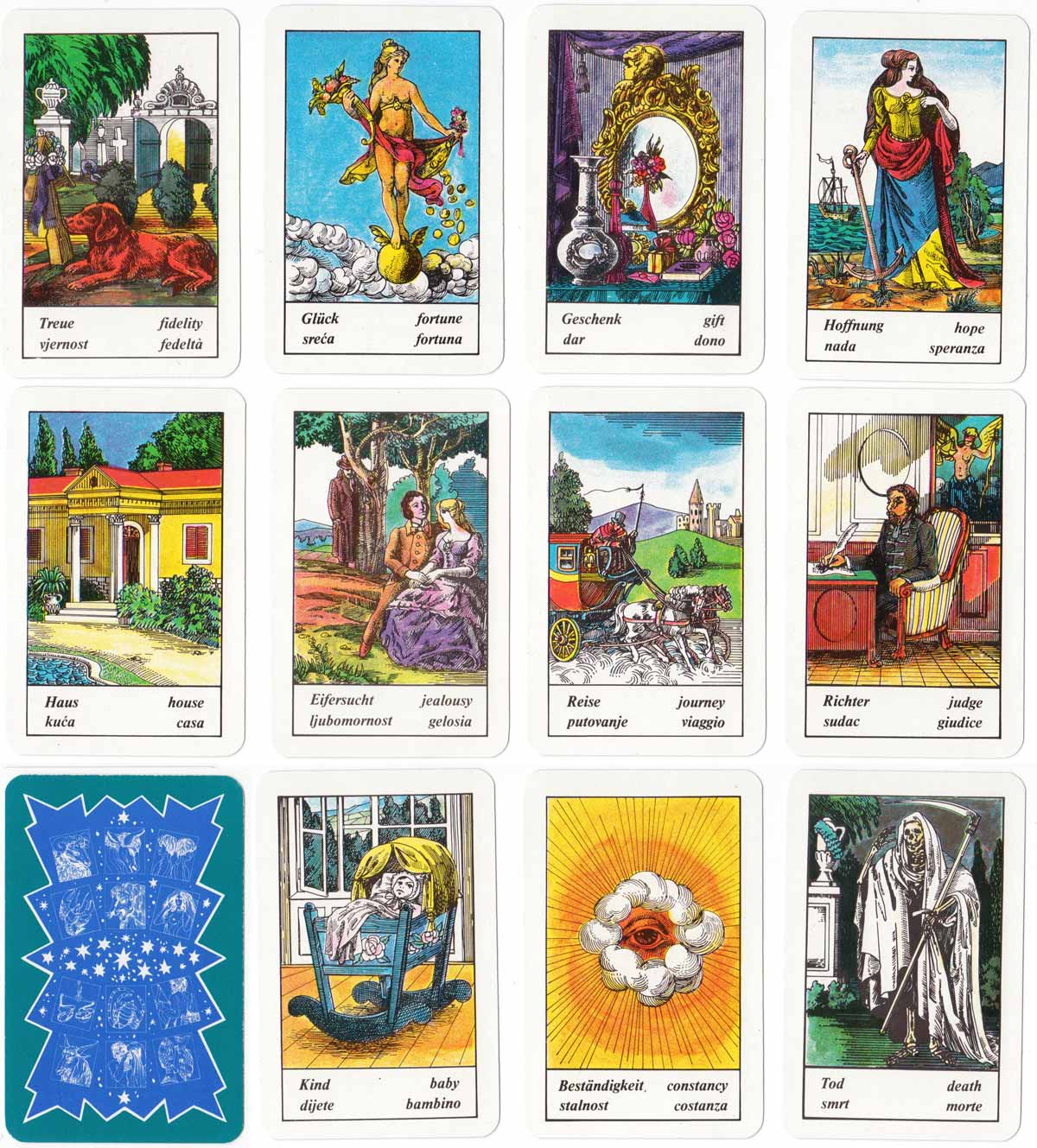
Above: Hungarian Fortune Telling Cards with captions in four languages. 36 cards. The images, which may serve to facilitate clairvoyance, are both allegorical and direct: Hope is a woman with an anchor, Fidelity shows a dog by his master's grave, Constancy is an all-seeing eye. Some additional images in this example include Widow, Widower, Visit, Unexpected Joy. Images courtesy Rex Pitts.
Piatnik “Zigeuner” Fortune Telling Cards
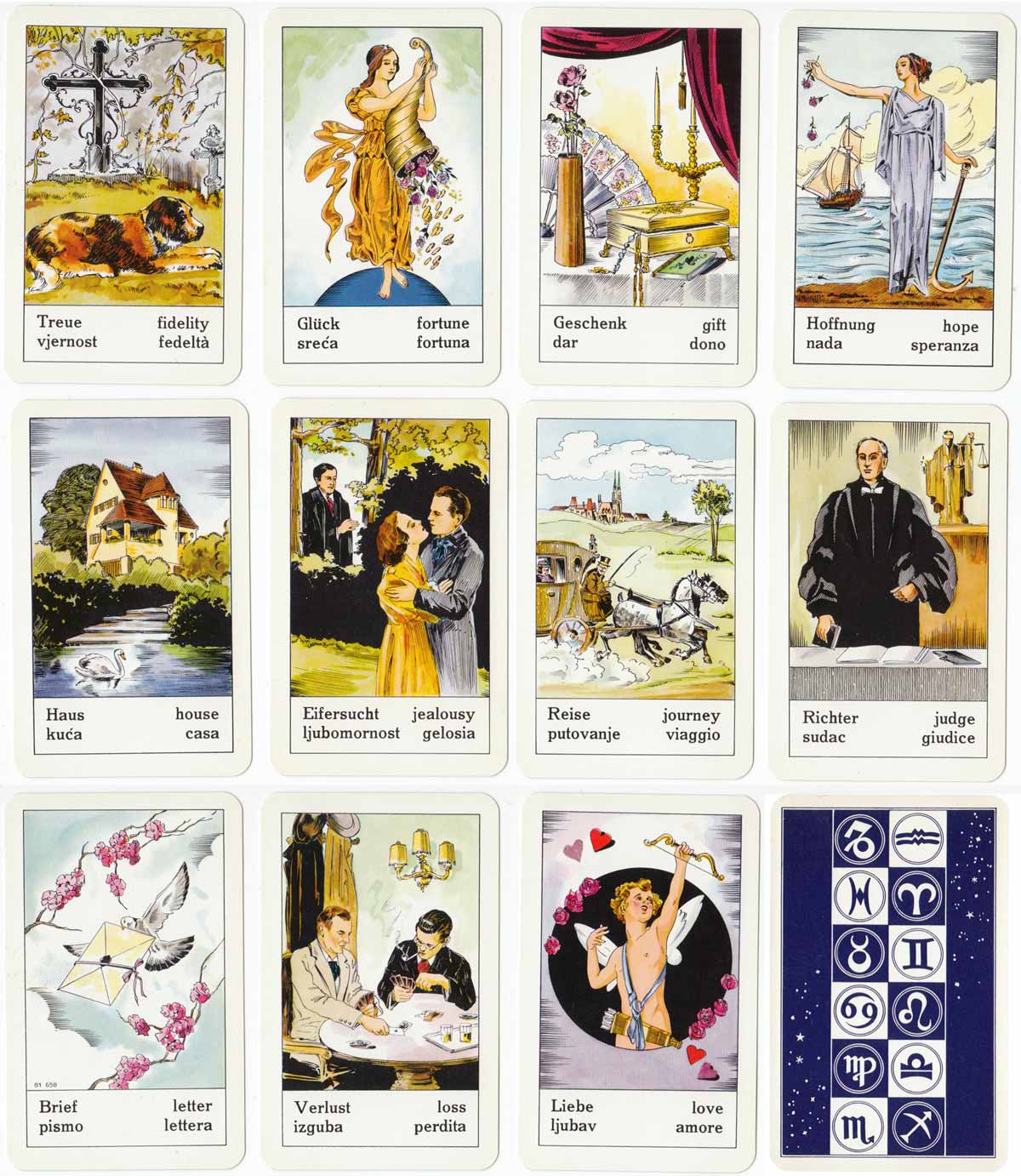
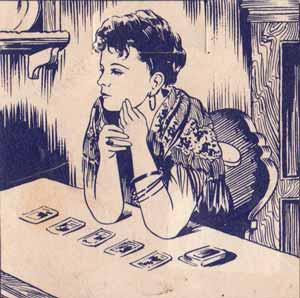
Above: Piatnik Fortune Telling Cards Nr.1 Nr.1902 manufactured in Austria. The images were updated into a more contemporary watercoloured pen and ink style of around the early 1900s, and the back design includes Zodiac symbols. These were also sold in different language editions as “Zigeuner” or “Gypsy Fortune Telling Cards” which adds an air of mystery. Images courtesy Rex Pitts.
See also the Art-Deco Fortune Telling deck published by Piatnik→
German Fortune Telling Cards - a possible source
A 36-card deck of German-suited Fortune Telling cards published by Industrie Comptoir, Leipzig c.1818, has inscriptions in German and Polish. There are no miniature playing cards inside the design, but instead the German suit symbols. Similarly, another example was published in c.1830 (below). Although these cards have suit symbols and a court hierarchy, the vignettes on the numeral cards are in many instances forerunners of the fortune telling cards shown above. It is likely that the Lenormand type cards also share the same common ancestry and derive from late 18th century cards but have evolved into different styles.
Note: Mary Greer has shown that the earliest forerunner of the Lenormand cards is a 1796 book in English. See: Mary K. Greer's Tarot Blog→
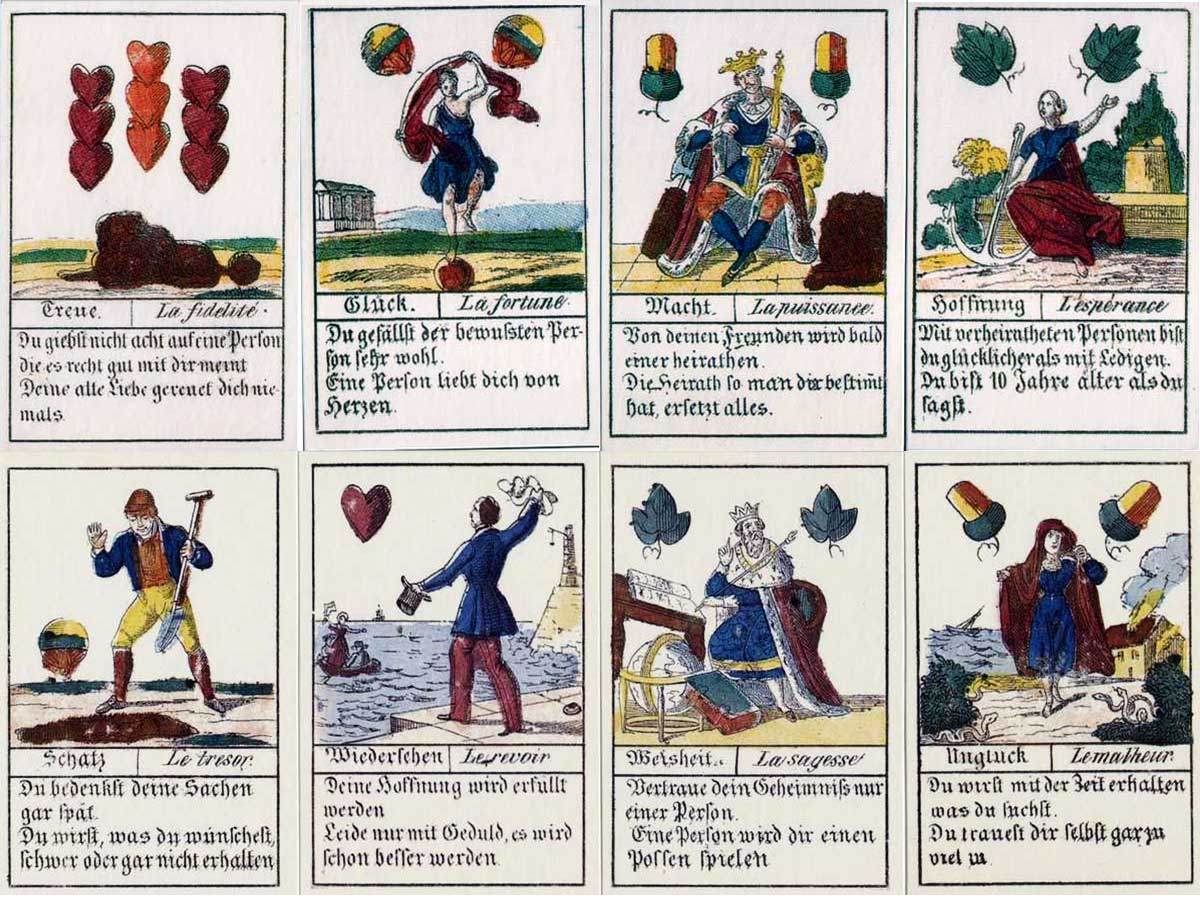
Above: 32-card German Fortune Telling deck manufactured by Industrie Comptoir, Leipzig, c.1830.

Above: 'Bohemios jugando a las cartas' by Jules James Rougeron (1841-1880).

By Rex Pitts (1940-2021)
Member since January 30, 2009
Rex's main interest was in card games, because, he said, they were cheap and easy to get hold of in his early days of collecting. He is well known for his extensive knowledge of Pepys games and his book is on the bookshelves of many.
His other interest was non-standard playing cards. He also had collections of sheet music, music CDs, models of London buses, London Transport timetables and maps and other objects that intrigued him.
Rex had a chequered career at school. He was expelled twice, on one occasion for smoking! Despite this he trained as a radio engineer and worked for the BBC in the World Service.
Later he moved into sales and worked for a firm that made all kinds of packaging, a job he enjoyed until his retirement. He became an expert on boxes and would always investigate those that held his cards. He could always recognize a box made for Pepys, which were the same as those of Alf Cooke’s Universal Playing Card Company, who printed the card games. This interest changed into an ability to make and mend boxes, which he did with great dexterity. He loved this kind of handicraft work.
His dexterity of hand and eye soon led to his making card games of his own design. He spent hours and hours carefully cutting them out and colouring them by hand.
Related Articles

AKA M5 Motorway
Promotional playing cards for the Hungarian M5 Toll Motorway between Budapest and Röszk.

Luditz Pattern by Georg Geiselreiter
The discovery of 2024 changes the current state of knowledge of the history of this pattern.

CARD-AB Miltenberg
Illustrations by Rita Stern depicting notable landmarks and scenes from the town of Miltenberg in Ge...

New Altenburg Skat cards – German DDR Pattern
Authentic Altenburger Skat cards with German suits (Acorns, Hearts, Leaves, Bells).

German Travel Cards
A travel-themed educational deck helping American tourists visiting Germany.

Briefmarken-Quartett
Quartet game featuring postage stamps from the Zones of Occupation in post-WWII Germany.

Ukraine playing cards
Historical figures from Ukraine’s past in a familiar Piatnik style.

MITSCHKAtzen
Clever cat designs by the Austrian artist and illustrator Willi Mitschka.

IG Chemie Papier Keramik
Promotional pack designed by Karl-Heinz Schroers for a German trade union with comical bears on the ...

Tarock Cards by NIL Spielkartenfabrik
A deck of tarock cards from the eastern end of the ending Austro-Hungarian Empire.

Whist by Ditha Moser
Ditha Moser created this minimalist Whist deck in 1905, in the style of the Vienna Secession art mov...

Tarot hiéroglyphique égyptien
The design of the cards draws inspiration from various religious and philosophical traditions merged...

Oracle Rock
Cartomantic set depicting rock and pop stars, designed by La Rata, with a book by Virginie Despentes...

Gabriel Uffenheimer
Rare example of the production of Johann Gabriel Uffenheimer, Guntramsdorf, 1825.

Eki karuta
Japanese fortune-telling cards based on I Ching, with bold, modern designs.

Engel-Tarot
Set of major arcana designed by Alois Hanslian depicting angels throughout.
Most Popular
Our top articles from the past 28 days


